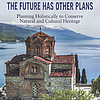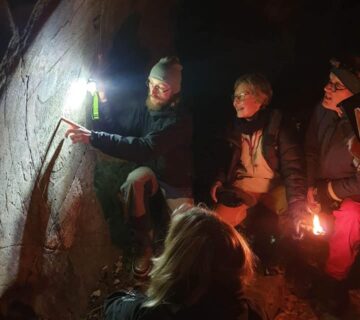There has been only one universe and one process of evolution, yet many human specialties divide it up. Interpret Europe needs clarity in its understanding of heritage to avoid erroneous assumptions
Buckminster Fuller said that after the Big Bang all categories are arbitrary. Indeed, the separation of natural and cultural heritage represents one major arbitrary category. That the 2017 motto for the European Heritage Days is ‘Heritage and Nature’ lays bare a massive assumption. Given that Interpret Europe is based on heritage interpretation, this request for ‘interpretive methods to connect natural and cultural heritage’ represents a prime opportunity to clarify its philosophical position on what heritage is.
Here is one interpretation to understand heritage. With the Big Bang, the process of evolution was unleashed. It appeared first at a galactic scale with the formation of the simplest elements (H, He, etc.) which coalesced into clouds and then suns whose heat forged heavier elements. Over time, evolution sped up to geologic time with planetary processes such as sedimentation, volcanism, tectonic plate formation, etc. Evolution continued to accelerate into biological time producing single-cell organisms and later complex multi-cellular organisms and communities. One such organism jumped into cultural evolution, much faster still, especially technological evolution.
So, one process of evolution operates at all scales. In fact, Ken Wilber has identified 20 tenets of universal evolution based around the idea of a holon which is both part as well as whole, such as a cell, an organism, a community, and so on.
- Reality as a whole is composed of ‘Holons’
- All holons display the fundamental capacity of agency or self-preservation
- All holons display the fundamental capacity of communion or self-adaptation
- All holons display the fundamental capacity of eros or self-transcendence
- All holons display the fundamental capacity of thanatos or self-dissolution
- Holons emerge
- Holons emerge holarchically
- Each emergent holon transcends but includes its predecessor(s)
- A lower holon sets the possibilities of the higher and the higher holon sets the possibilities of the lower
- The number of levels that a holarchy comprises determines whether it is ‘shallow’ or ‘deep’ and the number of holons on any level determines its ‘span’
- Each successive level of evolution produces greater depth and less span.
- The greater the depth of a holon, the greater its degree of Consciousness
- Destroy any holon and all the holons above are destroyed but none of the holons below
- Holarchies co-evolve
- The micro is in relational exchange with the macro at all levels of its depth
- Evolution has a directionality of increasing complexity
- Evolution has a directionality of increasing differentiation/integration
- Evolution has a directionality of increasing organisation/structuration
- Evolution has a directionality of increasing relative autonomy
- Evolution has a directionality of increasing telos/destiny
It is not necessary to explain these terms to understand that only one process of evolution has created all the universe, ‘natural’ and ‘cultural’. And at every step since the Big Bang, evolution has preserved traces or evidence of its work. We have, for instance, detected direct evidence of the Big Bang through quasars and expanding space as well as organisms on Earth that have long gone extinct. This evidence traces the universe’s single most important process and folds us into it. When this evolutionary evidence radiates with significance for people, we call it heritage.
Enlightenment era scientists, nonetheless, began to break up heritage into increasingly reduced fields of study. They assumed that humans were superior or apart from nature and thus our creations too stood apart from nature, called culture.
Aside from the break up, we easily find nature in all culture and in all nature, culture. All cultural heritage depends on a natural context, materials, patterns and symbols for inspiration, and of course biological organisms to author it. All nature depends on human interpretation, for example, the very concept of ‘nature’ is a cultural idea. Today as well not a square centimetre on Earth’s surface or cubic centimetre of the atmosphere has escaped alteration by human action. Even more, ‘natural’ and ‘cultural’ heritage continue to evolve ever while we debate this issue.
In summary, any interpreter who supports separating nature and culture colludes in this false dichotomy. If Interpret Europe were to offer suggestions as to how ‘to connect natural and cultural heritage’ it would replicate this archaic division. It would promulgate an erroneous understanding of heritage, slowing the integration that Modernity so needs to move onward from environmental and cultural destruction that we witness everywhere today.
These are harsh terms, I admit, but a heritage interpretation organisation should be clear about its view of heritage and its role with respect to its understanding and protection. But, then again, this is just my interpretation.
Jon is coordinator of the PUP Global Heritage Consortium, blogger of International Heritage Interpretation (www.facebook.com/heritageinterpretation), and co-author of the new book, The Future Has Other Plans: Planning Holistically to Conserve Natural and Cultural Heritage (www.pupconsortium.net/the-future-has-other-plans). He admits the natural/cultural split in his title is strictly marketing.
To cite this article:
Jon Kohl (2017) ‘Nature and cultural heritage are one and the same’. In Interpret Europe Newsletter 1-2017, 5
Available online:
https://www.interpret-europe.net/fileadmin/Documents/publications/Newsletters/ie-newsletter_2017-1_spring.pdf




